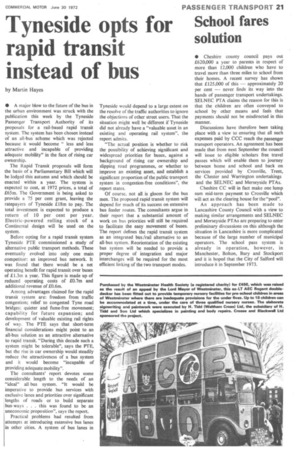Tyneside opts for rapid transit instead of bus
Page 23

If you've noticed an error in this article please click here to report it so we can fix it.
by Martin Hayes
• A major blow to the future of the bus in the urban environment was struck with the publication this week by the Tyneside Passenger Transport Authority of its proposals for a rail-based rapid transit system. The system has been chosen instead of an all-bus scheme which was rejected because it would become " less and less attractive and incapable of providing adequate mobility" in the face of rising car ownership.
The Rapid Transit proposals will form the basis of a Parliamentary Bill which will be lodged this autumn and which should be enacted within a year. The system is expected to cost, at 1972 prices, a total of £65m. The Government is being asked to provide a 75 per cent grant, leaving the ratepayers of Tyneside £18m to pay. The total investment is expected to produce a return of 10 per cent per year. Electric-powered rolling stock of a Continental design will be used on the system.
Before opting for a rapid transit system Tyneside PTE commissioned a study of alternative public transport methods. These eventually evolved into only one main competitor: an improved bus network. It was found that there would be a net operating benefit for rapid transit over buses of £1.3m a year. This figure is made up of reduced operating costs of £0.7m and additional revenue of £0.6m. Tyneside would depend to a large extent on the resolve of the traffic authorities to ignore the objections of other street users. That the Situation might well be different if Tyneside did not already have a "valuable asset in an existing and operating rail system", the report admits.
"The actual position is whether to risk the possibility of achieving significant and widespread priorities for buses, against a background of rising car ownership and slipping road programmes, or whether to improve an existing asset, and establish a significant proportion of the public transport system in congestion-free conditions", the report states.
Of course, not all, is gloom for the bus men. The proposed rapid transit system will depend for much of its success on extensive bus feeder routes. The consultants argue in their report that a substantial amount of work on bus priorities will still be required to facilitate the easy movement of buses. The report defines the rapid transit system as an integrated bus/rail alternative to an all-bus system. Reorientation of the existing bus system will be needed to provide a proper degree of integration and major interchanges will be required for the most efficient linking of the two transport modes.
Among advantages claimed for the rapid transit system are: freedom from traffic congestion; relief to congested Tyne road bridges: quieter and fume-free movement; capability for future expansion; and development of valuable existing rail rights of way. The PTE says that short-term financial considerations might point to an all-bus solution as an attractive alternative to rapid transit. "During this decade such a system might be tolerable", says the PTE, but the rise in car ownership would steadily reduce the attractiveness of a bus system and it would become "incapable of providing adequate mobility".
The consultants' report devotes some considerable length to the needs of an "ideal" all bus system. "It would be imperative to provide bus services with exclusive lanes and priorities over significant lengths of roads or to build separate bus-ways . . this was found to be an uneconomic proposition", says the report.
Practical problems had resulted from attempts at introducing extensive bus lanes in other cities. A system of bus lanes in




























































































